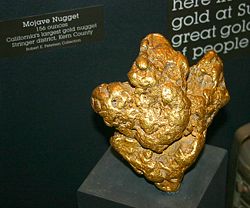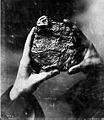Nugget: Difference between revisions
Jump to navigation
Jump to search

imported>George Swan (add image) |
imported>George Swan (add image) |
||
| Line 1: | Line 1: | ||
{{subpages}} | {{subpages}} | ||
[[Image:Gold | [[Image:Mojave Gold Nugget.jpg|thumb|250px|A 156 ounce gold nugget.]] | ||
A '''nugget''' is a term for a lump of raw metal. | A '''nugget''' is a term for a lump of raw metal. | ||
| Line 9: | Line 8: | ||
Large gold nuggets are rare enough that they are more valuable as curiousities, than as processed metal. | Large gold nuggets are rare enough that they are more valuable as curiousities, than as processed metal. | ||
<gallery> | |||
Image:Gold nugget from the nps -1.jpg|A large gold nugget from the Klondike Gold Rush. | |||
Image:Gold nugget from the Bureau of Land Management.jpg|A gold nugget, and an American dime for scale. | |||
</gallery> | |||
Revision as of 09:57, 25 August 2008
A nugget is a term for a lump of raw metal. It is common for rocks to contain some percentage of useful metals. But the metallic component of rocks is almost always compounded with some non-metallic elements. Some metals, like Gold and Copper, occur naturally in relatively pure form -- in recognizably metallic form. Pebble or cobble sized natural chunks of metal are called nuggets.
Large gold nuggets are rare enough that they are more valuable as curiousities, than as processed metal.


